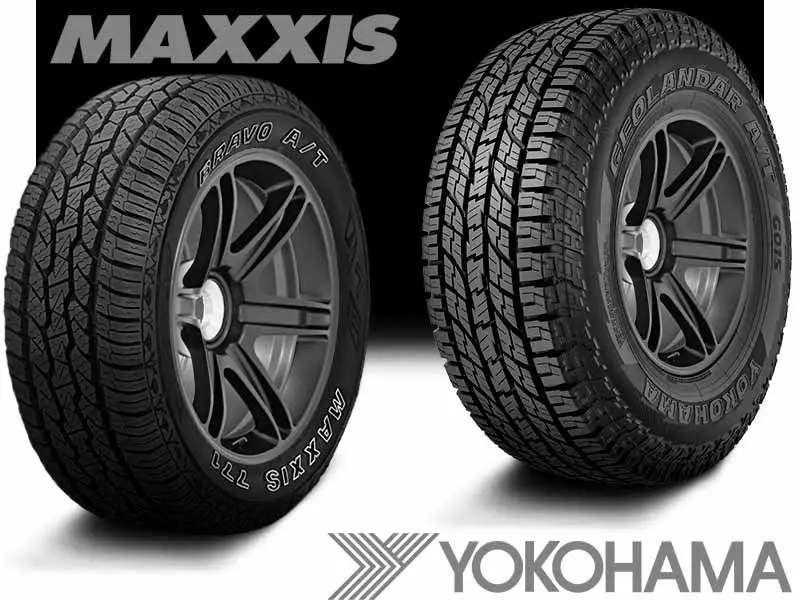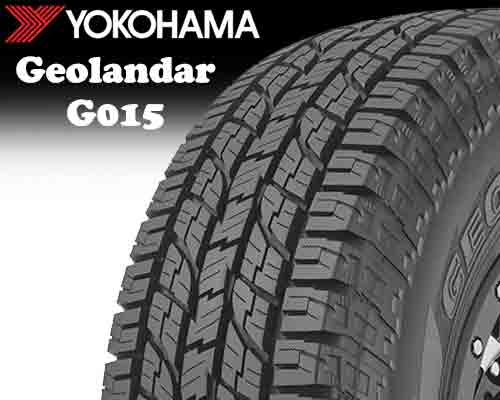Embarking on a journey of comparing the robust Maxxis Bravo 771 and the versatile Yokohama Geolandar AT G015, we dive into the intricacies of their design and performance. These all-terrain titans, each with their unique attributes, offer a compelling choice for off-road enthusiasts.
Let’s dissect their performance on all types of different terrains with the help of their tread design, though fist, lets take a look at their tire sizes, and specs.

| Dimensions | Yokohama Geolandar AT | Maxxis All Terrain 711 |
|---|---|---|
| Diameter (inches) | 15-22 | 15-20 |
| Speed Ratings | R, S, T, H | S, T, H |
| Load Ratings | SL, XL, C, D, E | XL, C, D, E |
| Weight Range (lbs) | 25-70 | 28-74 |
| Tread Depth (32″/in) | 12-18 (most sizes have 17/32″) | 12-16 |
| UTQG | 500 AB | 500 A B |
| Winter Ratings | M+S & 3PMSF | M+S, no 3PMSF |
| Warranty | 50k miles (LT sizes), 60k miles (non-LT) | No mileage warranty |
Table of Contents
Tread Structure
Both tires showcase unique, yet similar tread patterns, contributing to their all-terrain capabilities.
The Bravo All-Terrain 771 is characterized by a distinct design where the middle of the tread is dominated by S/Z-shaped blocks. Note how they are bisected (this is for enhancing their flexibility).

These central blocks are surrounded by a sequence of (almost) U-shaped lugs, that face towards the tire’s shoulders, enhancing the tire’s the off-road grip.
They all feature interlocking sipes, notches and in-groove biters, and all of them form 4 longitudinal grooves in the middle, where the outer two are a little wider separating shoulder lugs apart.
Speaking of which, the shoulder blocks carry similar features, though they are more packed up (so you get very tight lateral tread voids there).
And their outer margins are serrated. I mean each lug is staggered on itself. So they don’t make any mud scoops just like its counterpart (as you’d see).
And yes, they also join up with sidewall lugs, though they can use some rubber.
On the other side, the Yokohama Geolandar G015 forms a very similar columns (of blocks), where 4 circumferential channels are made.

Though all these blocks have have a lot more biters in the form of groove notches. I mean the three ribs in the middle, can be sen with both lateral and longitudinal zigzag slits in them, along with sharp off-set edges and full depth interlocking sipes.
Moreover, all these blocks are sitting on a continuous running vertical ribs, so you get tremendous on-road stability (as they act as reinforced foundations).
Same is the case with shoulder lugs, they also features solid supports underneath. Though they are less aggressive, compared to the ones in the middle.
They are very blocky, and don’t have as many biters, despite having notch-slits in them.
Furthermore, they also don’t form any traction scoops on the outer margins, though they are serrated and join up with sidewall lugs (which are just as good as the Maxxis tire, BTW).
Comfort Performance
Yokohama Geolandar G015 is a very comfortable tire to drive on. It’s better from not just Maxxis Bravo, but almost all other all terrain tires we have reviewed so far, (including Continental TerrainContact, one of the most on road based tire).
So what makes it so special?
Well, it provides a high silica content in it’s rubber’s composition, and this way the tire is very soft, yet elastic, dampening down bumps of the road in a very effective way, yet, no compromising a lot on durability.
The Maxxis Bravo 771 on the other side, although features a soft enough compound too, it’s shallower tread depth isn’t able to produce similar impact comfort performance, as it offer smaller rubber area for bumps to settle down.
Dry Traction
This section is basically two parts, dry handling, and directional grip.
The directional grip depends on the central tread area (as that part gets the most weight concentrations while rolling on highways). And it gets calculated with braking distances.
Now comparing both tires, there’s only a single feet difference between the two, with Yokohama taking the lead. So overall both tires are considered equal here.
Though major difference is seen in the handling department, which holds up a major chunk of overall dry performance, as it includes steering responsiveness too.
And Maxxis All Terrain 771 basically with slightly larger weight and a softer compound pushes its lugs to bend more against the road as it corners. This lowers the balance between the tires over and under steering, and in return compromising on overall handling, relatively.
So overall Geolandar A/T is a better pick here.
Wet road
Wet traction depends on sipes and grooves.
Grooves clear up the water out and away form the tread, while sipes suck up remaining water particles, so the biters could grip on the surface.
Now both tires offer similar hydroplaning resistance which has to do with grooves clearing water off, but there are some key differences to note when it comes to wet grip.
The Maxxis Bravo 771 although offer good enough wet traction at first, it doesn’t last, as the tire wears.
It’s tread basically offer good enough siping, they are not 3D. Meaning, they don’t feature full depth structures.
Whereas in case of Yokohama G015, those sipes go all the way down to the tread’s base, allowing for better water wiping abilities.
tread Life
Although both tires come with similar treadwear rating of 500 (UTQG), the Yokohama Geolandar A/T still gets to be better.
And this has to do with 2 things, tread depth, and weight.
The tire is significantly lighter in weight, so it’s lugs aren’t pressed against the road with as much force as they rub off the surface. This accounts for slower overall tread burning rate on this tire.
Moreover, it’s overall tread depth is greater on average, so this means it would take longer to reach down to tire replacement levels.
So that’s why, it makes sense why the Yokohama A/T gives you, up to 60k miles warranty, whereas Maxxis doesn’t come with any.
Fuel Economy
Fuel efficiency is highly related to the rolling resistance of the tire, which then highly depends on the tire’s weight (for the most part).
So it makes sense why Maxxis Bravo 771 is lacking behind in overall fuel economy performance.
The tire, despite having an on-road oriented design, gets to weigh a lot. This is mainly because of it’s 3 ply polyester casing (in its internal construction).
With greater weight, its lugs are pushed against the road with a larger force, which in return then generates larger rolling resistance values.
The Geolandar G015 on the other hand, although is not that great of a option for fuel either, it’s still better compared to Maxxis A/T, with it’s lighter weight, and longitudinal, continuous running central ribs, forming a more streamlined design with the road.
Durability
Yokohama Geolandar G015 offers a 2 ply polyester construction having 2 steel belts running on top, and then these belts are reinforced with spirally wrapped nylon (single ply).
On the other side, the Maxxis AT 771 comes with 3 ply polyester carcass with 2 belts and 2 cap plies of nylon.
So in terms of durability, we have a clear winner.
Snow Traction
Maxxis All Terrain 771 is not 3 peak as it’s only rated with M+S so it’s no surprise to see Yokohama Geolandar G015 performing better.
But why is that so?
Well that’s because Yokohama A/T simply gives you all the key ingredients which you usually see on winter tires. It’s skinnier, it has biters which hold on to the snow and it’s shoulder blocks don’t dig.
Being skinnier, the tire offers more pressure on snow and this combined with it’s countless biters (groove notches), the tire is simply a snow magnet.
The lodged snow in the grooves of Yokohama Geolandar, sticks so much better on the ground (as snowflakes have an interlocking design).
Lastly, with less aggressive shoulder blocks, the tire focuses less on digging and more on the forward momentum.
Off-Road performance
Off-road challenges brings about a wide range of demanding terrains, from muddy tracks to lighter (you can say easier) surfaces, like gravel roads. And when comparing these two tires here, I have to say, we find a variety of mixed results. Let me share them.
Talking about muddy terrains first, both tires are prone to becoming clogged with thick mud, no doubt about that.
Though still, if you have to pick one over the other, its better that you go with Maxxis Bravo 771. This is because the tire although comes with central continuous running rib, its surrounding lugs still have more open design, compared to the Yokohama G015, providing superior mud evacuation efficiency.
So this accounts for better mud clearing abilities on Maxxis.
Similarly, on rocky terrains where durability and biting efficacy are the most crucial variables, the Maxxis 771 outperforms its competitor, with its more durable 3-ply sidewalls.
Additionally, the tire also incorporates sidewall lugs that deliver improved biting efficacy when air pressure is reduced, making it the superior choice for off-road performance.
Though on sandy terrains, the Yokohama G015 with its lighter weight and smoother outer edges get to excel more, as these features allow to have smaller susceptibility to digging (which is the worst for sand traction).
To conclude
So overall it all comes down to this.
The Maxxis Bravo 771, even though features a very on-road oriented design form the outside, its internal construction consist of 3 ply polyester casing.
So this although renders this tire, more durable out the two, it also increases its weight significantly.
And with greater weight, the tire gets to show lacking performance in the fuel economy and tread life departments.
Though its overall dry and wet gripping efficacy is still pretty great.
Though when it comes to overall comfort, it can’t outperform Yokohama G015, which is in fact one of the best in A/T tires in this regard.